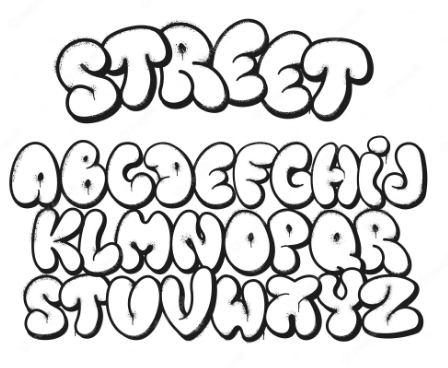The Art of Graffiti Letters Exploring Creativity and Expression
Graffiti letters have evolved into a distinct art form, capturing the essence of urban culture and personal expression. From the vibrant colors to the intricate designs, graffiti letters breathe life into the concrete landscapes. This article delves into the world of graffiti letters, exploring their various styles, techniques, and the significance they hold in contemporary society.
The Origins of Graffiti Letters:
Graffiti has a rich history that dates back to ancient times. The practice of leaving marks on walls and surfaces can be traced back to ancient civilizations like Egypt and Rome. However, it was in the 1960s and 1970s, amidst the rise of hip-hop culture in New York City, that graffiti letters as we know them today began to take shape.
Styles and Techniques:
Graffiti letters encompass a wide range of styles, each with its own unique characteristics. From wildstyle, bubble letters, and block letters to calligraphy and stencil art, graffiti artists employ various techniques to create visually stunning and highly individualistic pieces. These styles often combine lettering with images and symbols, further enhancing their artistic impact.
Expressing Identity and Social Commentary:
Graffiti letters serve as a powerful medium for artists to express their personal identity and voice their opinions on social issues. The walls become canvases for individuals to share their stories, experiences, and messages with the world. Whether it’s advocating for social justice, highlighting political unrest, or celebrating cultural diversity, graffiti letters can convey profound messages and provoke thought-provoking discussions.
The Impact on Urban Environments:
Graffiti letters have a significant impact on the aesthetic appeal and atmosphere of urban environments. When done with permission or in designated areas, graffiti can transform bland walls into vibrant displays of creativity, adding character and vitality to cities. However, illegal or unauthorized graffiti can also raise concerns about property damage and urban decay, sparking debates on the fine line between art and vandalism.
The Intersection of Graffiti and Mainstream Culture:
Over the years, graffiti letters have transcended their underground roots and entered the realm of mainstream culture. Street art festivals, exhibitions, and collaborations with commercial brands have helped legitimize graffiti as a recognized art form. Notable graffiti artists have gained international acclaim, with their works being celebrated in galleries and museums around the world.
Influences and Inspirations:
Graffiti letters draw inspiration from various artistic movements and cultural influences. From traditional calligraphy and typography to pop art and abstract expressionism, graffiti artists blend different elements to create their own unique styles. They are also influenced by music, fashion, and street culture, incorporating these influences into their lettering designs.
The Digital Era and Graffiti Letters:
The rise of digital technology and social media platforms has revolutionized the way graffiti letters are created and shared. Artists now use digital tools, such as graphic tablets and design software, to refine their lettering techniques. Additionally, platforms like Instagram have provided a global stage for graffiti artists to showcase their work, connect with fellow artists, and gain recognition.
Conclusion:
Graffiti letters are more than just colorful markings on walls. They represent an artistic movement that continues to evolve and inspire. From their humble beginnings in the streets of New York City to their presence in galleries and digital platforms worldwide. Graffiti letters have become a symbol of creative expression and a powerful form of visual communication. As we embrace the diversity and ingenuity of graffiti letters. We recognize their lasting impact on contemporary art and urban culture.
